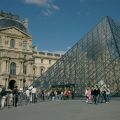Museum housing numerous pieces from Egypt, representing all the Muslim dynasties in Egypt.
A former royal palace, the famous Louvre boasts a very long history. It began in the late 12th century. In 1190, King Philippe Auguste (1180-1223) had a fortress built outside the city walls of Paris, occupying the south-western quarter of today's Cour Carrée. The 70-80 metre-long structure was surrounded by a moat, while its thick walls were flanked by towers and had only two entrances. In the center was the keep, a large tower that served as a safe and prison, among other functions. The reason for this massive construction was the imperative need to defend the town, in particular by keeping watch over the Seine, an invasion route used by men from the north, commonly known as Vikings, since Carolingian times. It was during the construction of the Grand Louvre that archaeologists unearthed the remains of this first building in the 1980s. Today, some of these architectural elements are freely accessible. Take a stroll along the Carrousel's wide shopping arcades, past the old moat, the north-east corner tower and the foot of the keep destroyed in 1528. Not far away, in the "Medieval Louvre" rooms renovated in 2016, numerous objects from this period are on public display. In the Crypt Saint-Louis, apparently the oldest room in the palace, where the remains of a decoration dating from the reign of Saint Louis (1226-1270) were discovered, you can also see numerous artifacts testifying to daily life at the time, as well as a gilded copper parade helmet said to have belonged to King Charles VI, known as le Fou (1368-1422). In the Model Room, visitors can discover the transformations that have marked the history of the Louvre palace over the centuries, as well as its decorations, notably those by Jean Goujon (16th century). Remains of the Tuileries Palace, built by Catherine de Médicis and destroyed in 1871 during the Paris Commune, can also be seen. As the city grew in the Middle Ages, the Louvre gradually lost its defensive function. The building became a royal residence, notably under Charles V the Wise (1338-1380), but it was Francis I (1494-1547) who had the defensive keep demolished and began the profound transformations that followed. These changes continued until the reign of Charles IX (1550-1574). The west and south sides of the medieval enclosure were replaced by two elegant Renaissance wings. And it was under Henri IV (1553-1610) that the Palais du Louvre and the Palais des Tuileries were united. The Cour Carrée, designed by architects Lemercier and Le Vau, dates back to the reigns of Louis XIII (1601-1643) and Louis XIV (1638-1715). The palace was also decorated and fitted out in the style of the day, by the masters Poussin, Romanelli and Le Brun, until Louis XIV decided to move his court to Versailles. After a period of relative neglect, the Louvre underwent further transformations in the 18th century, becoming a museum. Another story... and one whose origins can be traced back to an even more distant past. In the 16th century
Did you know? This review was written by our professional authors.
The strengths of this establishment:
Members' reviews on MUSÉE DU LOUVRE
The ratings and reviews below reflect the subjective opinions of members and not the opinion of The Little Witty.

















Riche et varié.
A refaire.
Le musée manque parfois d'explications écrites mais l'audioguide (mais payant en plus du billet) est très fourni en revanche.